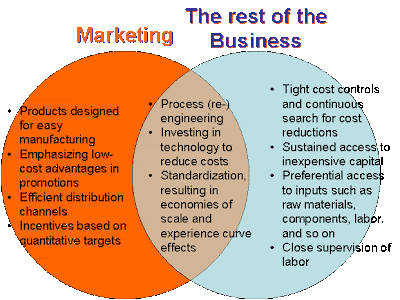A Low Cost Business Strategy features tactics which emphasize efficiency, including:

- Products designed for easy manufacturing
- Emphasizing low-cost advantages in promotions
- Efficient distribution channels
- Incentives based on quantitative targets
- Process (re-) engineering
- Investing in technology to reduce costs
- Standardization, resulting in economies of scale and experience curve effects
- Tight cost controls and continuous search for cost reductions
- Sustained access to inexpensive capital
- Preferential access to inputs such as raw materials, components, labor, and so on
- Close supervision of labor
- Items 1 to 4 are things that a Marketing Team is responsible for, and which it brings to Finance and Operations.
- Items 8-11 are owned by Finance and Operations they bring these back to the Marketing Team.
- Items 5-7 are things that are universally applicable.
- Efficient distribution channels - What could be more efficient than the web? For a moment, consider the web exclusively as a sales channel - that is just your website and not the opportunity for advertising. Typically you have a relatively fixed cost for your website. It doesn't matter if you sell one widget or a billion. Once you scale for your sales, the cost will remain fairly consistent, and will be very small relative to the costs you'd need to spend for a similarly sized store-front or sales team. Similarly, go out and price an advertising campaign in the (dying) newspaper industry, and compare that to action-based keyword advertising on Google. The order of magnitude lower cost difference you will find in web-based advertising and the order of magnitude action difference you will find there too is boggling.
- Incentives based on quantitative targets - Imagine you are an airline, and you pay a 10% commission to Travel Agents. If you have $1Billion in sales, you'd be paying your travel agents $100 MILLION. Imaging what you could do with your website for $100 million. Now you can't replace your entire traditional Travel Agent team with your website, but you can go a long way in doing so at a substantially lower cost. Some food for thought ... maybe the budget for your web marketing should be set as an incentive! The better your Web Marketing does, the more cash is available for it do to better.
- Process (re-) engineering - To put your business on the web, one of the first actions you need to take is to map your business processes. This applies to every activity that you are putting on the web. Let's say you are going to reallocate your advertising budget from traditional newspaper and out-of-home media to that new-fangled web stuff. The first thing you should do is figure out how you conceive, create, approve, and publish your ads for the traditional world. The next thing is to look at how you will do that for the web world. Then apply those lessons back to the traditional world and cut out all the fat you can from all processes. In the end you will have processes that are aligned, and engineered for efficiency.
- Investing in technology to reduce costs - If the web isn't technology, what is? It is time to invest in fixed assets to reduce your business costs. Map out business processes for attracting prospects to your site, closing sales, upselling and cross-selling, serving customers, and getting them to come back to your store again. Then turn theses business processes into a technology road-map that will help you automate your business processes for advertising, selling, and serving your customers online.
You and Marketing Team need to get going on Low Cost Business Strategies. Contact Market GoGo to see how we can help you do this.





No comments:
Post a Comment